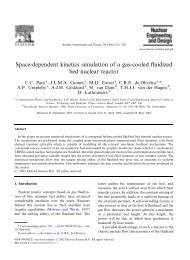Chapter 8 Configuring Fluidity - The Applied Modelling and ...
Chapter 8 Configuring Fluidity - The Applied Modelling and ...
Chapter 8 Configuring Fluidity - The Applied Modelling and ...
You also want an ePaper? Increase the reach of your titles
YUMPU automatically turns print PDFs into web optimized ePapers that Google loves.
32 Numerical discretisation<br />
In a similar way, a weakly imposed Dirichlet boundary condition can be related to an integration by<br />
parts of the advection term. Let us consider a pure advection problem (µ = 0). <strong>The</strong> weak form of this<br />
equation integrated by parts reads:<br />
�<br />
Ω<br />
ϕ ∂c<br />
�<br />
− (∇ · ϕ u) c + n · u c = 0.<br />
∂t ∂Ω<br />
<strong>The</strong> last (boundary) term can again be substituted by a weakly imposed boundary condition c = gD.<br />
In this case however we only want to impose this on the inflow boundary, <strong>and</strong> the original term<br />
remains for the outflow boundary:<br />
�<br />
Ω<br />
ϕ ∂c<br />
�<br />
�<br />
− (∇ · ϕ u) c + n · u gD + n · u c = 0, (3.24)<br />
∂t ∂Ω−<br />
∂Ω+<br />
where ∂Ω− <strong>and</strong> ∂Ω+ refer to respectively the inflow (n · u > 0) <strong>and</strong> outflow boundaries (n · u < 0).<br />
It is to be noted that when we are applying boundary conditions weakly we still consider the full<br />
set of test functions, even those that don’t satisfy the boundary condition. This means the discrete<br />
solution will not satisfy the boundary condition exactly. Instead the solution will converge to the<br />
right boundary condition along with the solution in the interior as the mesh is refined.<br />
An alternative way of implementing boundary conditions, so called strongly imposed boundary conditions,<br />
is to restrict the trial space to only those functions that satisfy the boundary condition. In<br />
the discrete trial space this means we no longer allow the coefficients ci that are associated with the<br />
nodes xi on the boundary, to vary but instead substitute the imposed Dirichlet boundary condition.<br />
As this decreases the dimension of the trial space, we also need to limit the size of the test space.<br />
This is simply done by removing the test function ϕi associated with the nodes xi on the boundary,<br />
from the test space. Although this guarantees that the Dirichlet boundary condition will be satisfied<br />
exactly, it does not at all mean that the discrete solution converges to the exact continuous solution<br />
more quickly than it would with weakly imposed boundary conditions. Strongly imposed boundary<br />
conditions may sometimes be necessary if the boundary condition needs to be imposed strictly for<br />
physical reasons.<br />
3.2.3 Discontinuous Galerkin discretisation<br />
Integration by parts can be used to avoid taking derivatives of discontinuous functions. When using<br />
discontinuous test <strong>and</strong> trial functions (see Figure 3.5) however, neither the original advection equation,<br />
(3.5) with µ = 0, nor the version (3.24) integrated by parts are well-defined. Within an element<br />
e however the functions are continuous, <strong>and</strong> everything is well defined. So within a single element<br />
we may write<br />
�<br />
e<br />
ϕ ∂c<br />
�<br />
− (∇ · ϕ u) c + ∇ϕ · µ · ∇c + ϕ �n · u c − ϕ<br />
∂t ∂e<br />
� n · µ · ∇c = 0, (3.25)<br />
<strong>The</strong> hatted terms represent fluxes across the element facets: <strong>and</strong> therefore from one element to the<br />
other. Due to the discontinuous nature of the fields, there is no unique value for these flux terms,<br />
however the requirement that c be a conserved quantity does dem<strong>and</strong> that adjacent elements make<br />
a consistent choice for the flux between them. <strong>The</strong> choice of flux schemes therefore forms a critical<br />
component of the discontinuous Galerkin method.<br />
<strong>The</strong> application of boundary conditions occurs in the same manner as for the continuous Galerkin<br />
method. <strong>The</strong> complete system of equations is formed by summing over all the elements. Assuming




